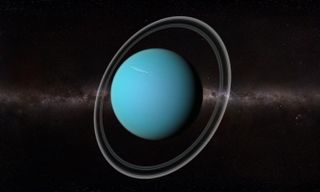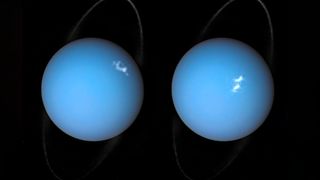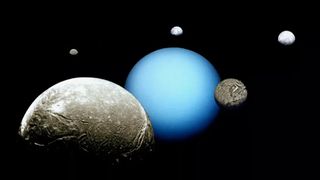Uranus: Everything you need to know about the coldest planet in the solar system
Uranus is the seventh planet from the sun and was the first to be discovered with a telescope.

Uranus is the seventh planet from the sun and the third largest planet in the solar system.
Although Uranus is visible to the naked eye, it was long mistaken as a star because of the planet's dimness and slow orbit.
The planet is also notable for its dramatic tilt, which causes its axis to point nearly directly at the sun.
Related: Sounds in space: What noises do planets make?
Who discovered Uranus?
British astronomer William Herschel discovered Uranus on March 13, 1781, with his telescope while surveying all stars down to those about 10 times dimmer than can be seen by the naked eye. One star seemed different, and within a year Herschel realized the star followed a planetary orbit.
Uranus (as it was called commonly after 1850 or so) was named after the Greek sky deity Ouranos, the earliest of the lords of the heavens. It is the only planet to be named after a Greek god rather than a Roman one. Before the name was settled on, many names had been proposed for the new planet, including Hypercronius ("above Saturn"), Minerva (the Roman goddess of wisdom) and Herschel, after its discoverer. To flatter King George III of England, Herschel proposed the name Georgium Sidus ("The Georgian Planet"), but the idea was unpopular outside England and King George's native Hanover, Germany.
German astronomer Johann Bode, who detailed Uranus' orbit, gave the planet its ultimate name. Bode argued that as Saturn was the father of Jupiter, the new planet should be named after the father of Saturn.
Physical characteristics
Uranus is blue-green in color, as a result of the methane in its mostly hydrogen-helium atmosphere. The planet is often dubbed an ice giant, since at least 80% of its mass is a fluid mix of water, methane and ammonia ice.
Unlike the other planets of the solar system, Uranus is tilted so far that it essentially orbits the sun on its side, with the axis of its spin nearly pointing at the star. This unusual orientation might be due to a collision with a planet-size body, or several small bodies, soon after it was formed. A 2018 study suggested the colliding world could have been twice the size of Earth.
This unusual tilt gives rise to extreme seasons that last for about 20 years. This means that for nearly a quarter of the Uranian year, which is equal to 84 Earth-years, the sun shines directly over each pole, leaving the other half of the planet to experience a long, dark and frigid winter.
Uranus has the coldest atmosphere of any of the planets in the solar system, even though it is not the most distant from the sun. That's because Uranus has little to no internal heat to supplement the heat from the sun.
The magnetic poles of most planets are typically more or less lined up with the axis along which it rotates, but Uranus' magnetic field is tilted, with its magnetic axis tipped nearly 60 degrees away from the planet's axis of rotation. This leads to a strangely lopsided magnetic field for Uranus, with the strength of the field at the northern hemisphere's surface being up to more than 10 times that of the strength at the southern hemisphere's surface. A 2017 study suggested the lopsided nature of Uranus' magnetic field may also lead it to flicker on and off during every rotation (about every 17.24 hours).
Uranus' atmospheric composition by volume is 82.5% hydrogen, 15.2% helium and 2.3% methane. Its internal structure is made up of a mantle of water, ammonia and methane ices, as well as a core of iron and magnesium silicate. Uranus' average distance from the sun is roughly 1.8 billion miles (2.9 billion km), according to NASA. That's about 19 times the distance from the Earth to the sun.
Uranus FAQs answered by an expert
We asked Ravit Helled, a planetary scientist specializing in planet formation, planet interiors, planetary evolution, and solar system physics a few commonly asked questions about Uranus.

Ravit Helland is a Professor at the Institute for Computational Science, Center for Theoretical Astrophysics and Cosmology, University of Zurich, who specializes in planet formation, planet interiors, planetary evolution, and solar system physics.
What type of planet is Uranus?
Uranus is known to be an 'ice giant' although the name is a little bit misleading. It's a different type of planet from the gas giant planets like Saturn and Jupiter, and the terrestrial planets like Earth or Mars. It's part of a unique group together with Neptune in our solar system.
It's also what we call an intermediate-mass planet because it's much more massive than terrestrial planets possessing around 15 times the mass of Earth. At the same time, Uranus is much smaller than the gas giant planets like Jupiter and Saturn which have over 300 and nearly 100 times the mass of Earth, respectively.
Uranus really is a unique type of planet and we don't understand this planetary type very well.
What makes Uranus the coldest planet in the solar system?
Uranus is the only planet that is really in thermal equilibrium with the sun and there are two options as to why its surface appears cold. Firstly it could just actually be that Uranus is hot in its interior, but this heat is trapped. That means it can't cool down so it's hot inside but cold outside.
Alternatively, it may be that it just managed to lose its primordial heat, for example, via a giant impact or another unknown process. So the short answer is we don't really know why it's cold and this is one of the biggest mysteries surrounding Uranus.
What do we currently know about the composition of Uranus?
The composition of Uranus is unknown we need to have a spacecraft visit it and get better and complimentary data. We think that it's composed of heavy elements, which in astrophysics means elements that are heavier than helium. Uranus is expected to have many 'ices' which could be water, ammonia, and methane, but also some rocks and hydrogen-helium. So it has mostly elements that are heavier than helium, and some hydrogen and helium atoms in its gaseous atmosphere.
While the composition of Jupiter and Saturn is governed by hydrogen and helium, and the composition of terrestrial planets is governed by heavier elements, Uranus is somewhere in between.
But what these heavy elements are, we don't know. It is thought to be some ice but not just water, it could also be methane and ammonia ice and in fact, these materials could be in the liquid/fluid phase. Uranus may also have silicates like rocks and we don't know what is the ratio between ice and silicate is inside the planet.
Why are Uranus and Neptune sometimes referred to as "twins"?
The ice giants are very similar in mass and sizes and also happen to be the furthest planets out in the solar system. They have other similarities like average density, but they definitely can't be called "identical twins."
They are different in the amount of heat they radiate, their axial tilt, and their satellite systems; Uranus has small regular moons and overall has 27 known moons, while Neptune's moon Triton is much larger and is probably a captured moon.
What we want to know is whether these unique differences are because of different formation processes, or if Uranus and Neptune were relatively similar after formation until other processes occurred that led to these differences. For example, did a gigantic impact at some point in the past cause some of these differences.
Understanding the origin of these differences between Uranus and Neptune is also critical to better characterize this planetary type.
How common are Uranus-like worlds in the rest of the Milky Way?
Based on the available data intermediate-mass planets seem to be one of the most common, if not the most common some of these exoplanets are so-called super-Earths and are not Uranus-like.
There's also the caveat that exoplanets we observe today are limited to planets that are quite close to their stars. This means the Uranus-like planets have not been observed yet because Uranus orbits very far from its host star, the sun.
Why are space scientists so interested in exploring Uranus?
Uranus really is a fascinating planet and is surrounded by many mysteries including its unusual multi-pole magnetic field rather than the dipole magnetic field we are used to.
I would like to know what Uranus is made of and determine its internal structure and also understand how it formed. Did it form where we see it today, or did it form further in the solar system and migrate out, or did it form further out and migrate in?
There are more open questions than answers surrounding Uranus at the moment and they are all somewhat interconnected. It's an unexplored world and rather poorly understood. So yeah, it's time to give it more attention.
What is Uranus made of?
The seventh planet in our solar system is a giant ball of gas and liquid. It is tilted so far on its side that its axis lies nearly level with its path around the sun. Like the other gas and ice giants, Uranus has a thick cloud cover. Its blue-green color is the result of methane in its atmosphere. Click on the interactive image below to explore the planet:
Uranus' climate
The extreme axial tilt Uranus experiences can give rise to unusual weather. As sunlight reaches some areas for the first time in years, it heats up the atmosphere, triggering gigantic springtime storms, according to NASA.
However, when Voyager 2 first imaged Uranus in 1986 at the height of summer in its south, the spacecraft saw a bland-looking sphere with only about 10 or so visible clouds, leading to it to be dubbed "the most boring planet," wrote astronomer Heidi Hammel in "The Ice Giant Systems of Uranus and Neptune," a chapter in "Solar System Update" (Springer, 2007), a compilation of reviews in solar system science. It was decades later, when advanced telescopes such as Hubble came into play and Uranus' long seasons changed, before scientists witnessed the extreme weather on Uranus.
In 2014, astronomers got their first glimpse at summer storms raging on Uranus. Strangely, these massive storms took place seven years after the planet reached its closest approach to the sun, and it remains a mystery why the giant storms occurred after the sun's heating on the planet was at a maximum.
Other unusual weather on Uranus includes diamond rain, which is thought to sink thousands of miles below the surface of icy giant planets such as Uranus and Neptune. Carbon and hydrogen are thought to compress under extreme heat and pressure deep in the atmospheres of these planets to form diamonds, which are then thought to sink downward, eventually settling around the cores of those worlds.
Does Uranus have rings?
The rings of Uranus were the first to be seen after Saturn's. They were a significant discovery, because it helped astronomers understand that rings are a common feature of planets, not merely a peculiarity of Saturn.
Uranus possesses two sets of rings. The inner system of rings consists mostly of narrow, dark rings, while an outer system of two more-distant rings, discovered by the Hubble Space Telescope, are brightly colored: one red, one blue. Scientists have identified 13 known rings around Uranus.
A 2016 study suggested that the rings of Uranus, Saturn and Neptune may be the remnants of Pluto-like dwarf planets that strayed too close to the giant worlds long ago. These dwarf planets were torn apart in the planets' vast gravities and are today preserved as rings.

How many moons does Uranus have?
Uranus has 27 known moons. Instead of being named after figures from Greek or Roman mythology, its first four moons were named after magical spirits in English literature, such as William Shakespeare's "A Midsummer Night's Dream" and Alexander Pope's "The Rape of the Lock." Since then, astronomers have continued this tradition, drawing names for the moons from the works of Shakespeare or Pope.
Oberon and Titania are the largest Uranian moons and were the first to be discovered, by Herschel in 1787. William Lassell, who was also the first to see a moon orbiting Neptune, discovered Uranus' next two moons, Ariel and Umbriel. Nearly a century passed before Dutch-American astronomer Gerard Kuiper, of Kuiper Belt fame, found Miranda in 1948.
In 1986, Voyager 2 visited the Uranian system and discovered an additional 10 moons, all just 16 to 96 miles (26 to154 km) in diameter: Juliet, Puck, Cordelia, Ophelia, Bianca, Desdemona, Portia, Rosalind, Cressida and Belinda. Each of those moons are roughly half water ice and half rock.
Since then, astronomers using Hubble and ground-based observatories have raised the total to 27 known moons, and spotting these was tricky — they are as little as 8 to 10 miles (12 to 16 km) across, blacker than asphalt and nearly 3 billion miles (4.8 billion km) away.
Between Cordelia, Ophelia and Miranda are a swarm of eight small satellites crowded together so tightly that astronomers don't yet understand how the little moons have managed to avoid crashing into each other. Anomalies in Uranus' rings lead scientists to suspect there might still be more moons.
In addition to moons, Uranus may have a collection of Trojan asteroids — objects that share the same orbit as the planet — in a special region known as a Lagrange point. The first was discovered in 2013, despite claims that the planet's Lagrange point would be too unstable to host such bodies.

Uranus exploration
NASA's Voyager 2 was the first and as yet, only spacecraft to visit Uranus. Although there isn't a spacecraft on its way to Uranus at the moment, astronomers regularly check in with the planet using the Hubble and Keck telescopes.
In 2011, the Planetary Science Decadal Survey recommended that NASA consider a mission to the icy planet. And in 2017, NASA suggested a number of potential future missions to Uranus in support of the forthcoming Planetary Science Decadal Survey, including flybys, orbiters and even a spacecraft to dive into Uranus' atmosphere. Scientists are still discussing the idea. In 2019, NASA's Goddard Space Flight Center suggested one possible design could involve an atmospheric probe, similar to the one used in Jupiter during the Galileo mission.
In 2018, an ambitious group of early-career scientists and engineers created a theoretical full mission design that would cost $1 billion, and take advantage of a planetary alignment that would happen in the 2030s. At that relatively low cost, the mission would perform minimal science, but could still include items such as a magnetometer, a methane detector and a camera.
Related: Uranus by 2049: Here's why scientists want NASA to send a flagship mission to the strange planet
Additional resources
To see a live-time interactive graphic of the planet, visit NASA's overview of Uranus page. Alternatively, you can learn more about Uranus' numerous moons, from NASA.
Bibliography
"Uranus". NASA Solar System Exploration (2022).
"12 interesting facts about Uranus". Universe Magazine (2022).
"Uranus: Facts, Moons & Rings". Encyclopaedia Britannica (2022).
"The rings of Uranus". Nature (1977).
Join our Space Forums to keep talking space on the latest missions, night sky and more! And if you have a news tip, correction or comment, let us know at: community@space.com.
Get the Space.com Newsletter
Breaking space news, the latest updates on rocket launches, skywatching events and more!

Charles Q. Choi is a contributing writer for Space.com and Live Science. He covers all things human origins and astronomy as well as physics, animals and general science topics. Charles has a Master of Arts degree from the University of Missouri-Columbia, School of Journalism and a Bachelor of Arts degree from the University of South Florida. Charles has visited every continent on Earth, drinking rancid yak butter tea in Lhasa, snorkeling with sea lions in the Galapagos and even climbing an iceberg in Antarctica. Visit him at http://www.sciwriter.us
